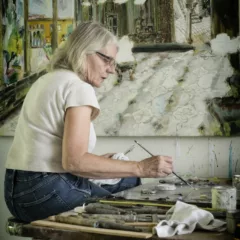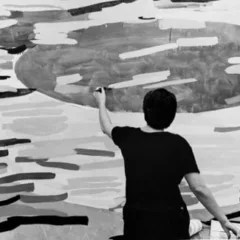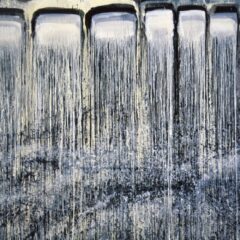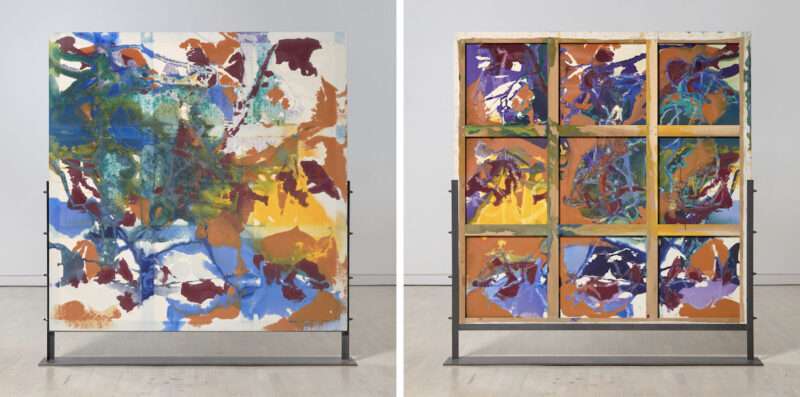
Our eyes are hungry in the city in winter. We are starved for greens, purples, yellows, oranges, reds…we want to pierce the tender skin and sink into the bright flesh of spring. At Dona Nelson’s work, we can eat in full. The spring is not, or not just, pretty flowers. It is the cold damp thawing ground, creating an endless thick mud that will swallow your shoes. It is the dead plants and animals that didn’t make it, a reminder that life grows from graves. Dona’s paintings not only contain life within, but between them. All viewers look alive in front of the work, winter’s pale cast removed, eyes wide and alert like new buttons, meeting the paintings. They must meet them because the works introduce themselves, some standing completely apart from the wall, utterly unafraid.
Dona does not make us sniff through the muck on the ground ourselves, but generously tilts the work vertically so we may visually dine in a more civil manner. They are a person who sees their role as an intermediary between sky and earth, a measurer of gravity.
“Words allude, painting connects to reality in a different way. The earth is there and the sky is there and I’m here – that’s what painting’s about.” (Dona Nelson)
What happens when you can’t think of any words worth saying? But there is still something to express, to be let out, to measure. Nelson has waning confidence in words to express experience, but let’s proceed, what is more noble than failure?
Early spring is traditionally the starving season, winter’s cache has been emptied and the yield from the earth is too young to eat. A discussion took place at Locks Gallery on April 5, 2024, with Sarah McEneaney (exhibiting Morning Noon Night on the ground floor of the gallery), Dona Nelson, and curators Ian Berry and William Valerio. All quotes and references are taken from that conversation.
Nelson expressed that pouring paint and working is how they connect to the universe. The works are something like a weather report. They are evidence, they are not pictures or illusions, they are facts. Nelson expresses that they mix up the colors, and choose the piece of canvas, but the gravity and the canvas make the painting, “Sometimes I leave them (the paintings) out to be rained on a bit,” they said.
Although the grass is now growing out of the mud, at the time of writing, leaves are still not on my neighborhood trees. Like many artists in Philadelphia, years ago I was a student of Dona Nelson. They were tough. During our final critique, they advised me to stop drawing for 3 years. Taking the statement as rejection, I left painting for sculpture and unconsciously took their advice. As I returned to painting and drawing as a medium, I felt their words like a lemon, sweet and sour, in my mouth. I couldn’t believe it, they turned out to be right. They saw I was stuck inside a method of drawing for which I previously received praise, and they, not very delicately but with a certain style, took away the meaningless trophy I was clutching, and now I have built a much richer art practice. Many past students have such stories, and one is hard-pressed to view Nelson’s artwork in Philadelphia and not hear a Dona story.
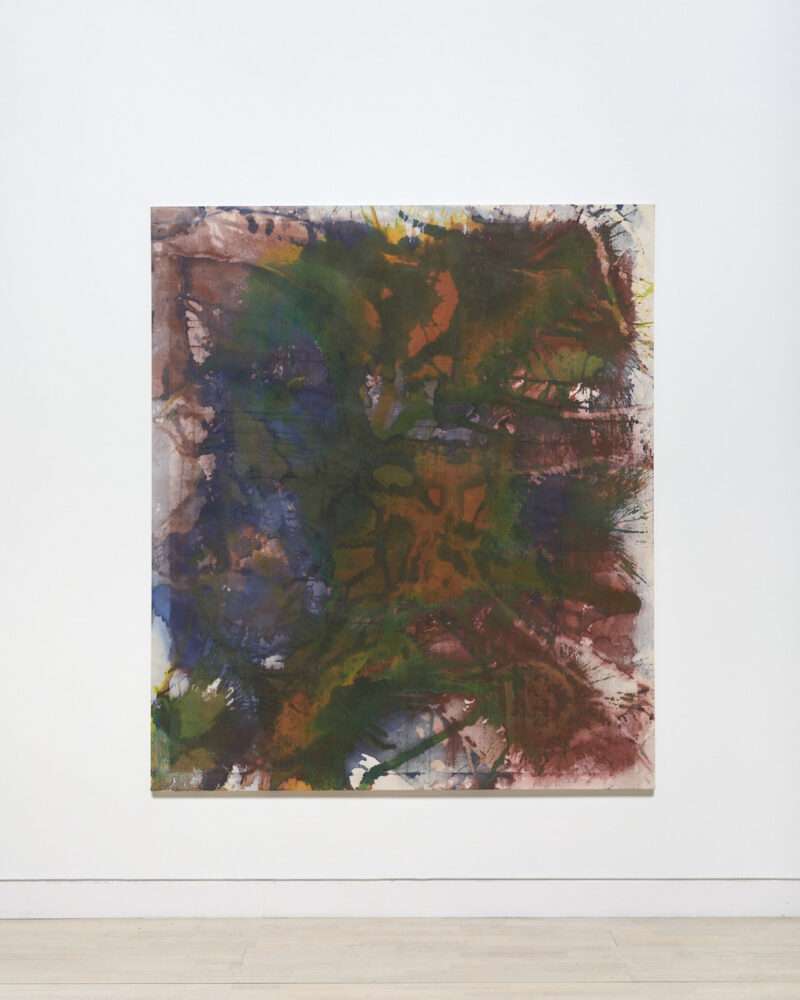
Painting surfaces seem to invent colors or to dig them up for us upon viewing. We are not able to use such crude words for them such as “green”, “yellow”, “brown”, or “blue”, we must call them matted algae and screaming dandelion and clotting blood and varicose veins. Even those descriptors aren’t enough, similar to when you are learning a language and must make direct and sometimes sloppy translations of the colors into words.
We must also learn how to look again while looking at the paintings. We move from one side to the other, carrying the previous painting in our minds. I found often the second side’s viewing would tinker with my memory of the previous side, and when I would walk back over to it, it was different again! Some of the backsides of the work are positioned rather close to the wall, they create a clandestine booth with walls like stained glass. Others have their backs exposed broadly, dragging out a rather intimate exchange into public. One is impressed by the generosity of this gesture, but when grown accustomed to it, one fiendishly wonders what secrets the wall-hung pieces hold.
There is something of this lost when looking through photographic images of the work, the work simply must be seen in person. “Painting is not illusion, it’s real,” says Nelson. Like a giant game of hide and seek, your body travels between paintings like book pages where the next obscures the previous. Nelson said, “I love sculpture as much as painting; I wish I had several lifetimes.” Her paintings step into object-hood by simply standing apart from the wall. Each facet delivers something else, like an actor performing in the round. We may see a different characterization from every side. Although the paintings are massive and still, due to the installation of them standing upright throughout the space, they turn in and out of view. You might turn to reference a moment in a work to find it gone, or completely changed.
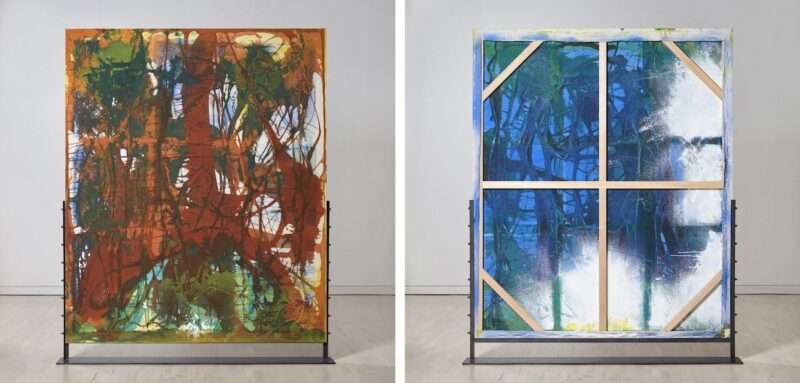
Surfaces, pulled taut taught and trim, have been through a lot. Nelson spoke about pouring paint into the unprimed canvases until they scream, “No Dona! Not one more drop!” Their fibers have been filled and flipped and soaked and put on stretchers and taken off stretchers and had things attached and ripped off and sewn, and and and. They have earned their terrific beauty in the survival of their author’s unyielding studio practice.
“I can’t explain why but painting is a very profound thing,” Nelson said, discussing the importance of painting to the world. “Painting is a form that keeps producing itself – it does not finish. The painting is never finished.” They described that as long as the viewer is alive, the painting continues to make itself in your mind again and again, never completing or dying out. I know this to be true, I remember deeply my father’s favorite paintings, because he showed them to me but also the way he described them and the way he carried them. The way that “Saturn Devouring His Son” by Francisco Goya, or “The Garden of Earthly Delights” by Hieronymus Bosch would find their way into daily conversation, and become physically embodied. The way that Dona’s favorite paintings enter her physicality creates a dialogue between herself and Abstract Expressionist artists like Jackson Pollock. Painting is alive.
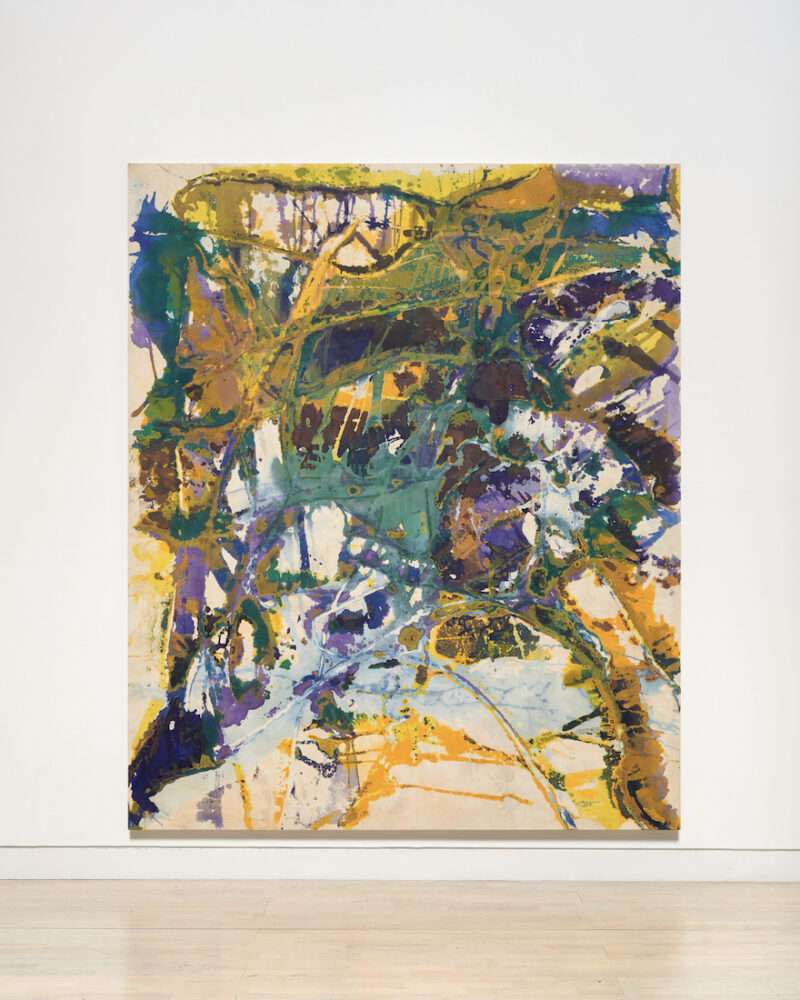
During the gallery talk, a question was asked about politics. Nelson said, “It’s beyond what I can see; I don’t know the social purpose of painting.” Maybe it’s this: If painting is alive, life wins out, no matter how much bitter and cruel death surrounds us, life sprouts in spring. With any luck, this spring will ring in an abatement of violence and an acceptance of life. Although words are less real than paintings, I’m going to use a tone of certainty. All of us in Philadelphia who have been working hard to maintain hope and fight for justice through these long winter months will exhale a cruel winter and inhale a brilliant spring of ceasefire. May the churning soft ground of spring give birth to a Free Palestine and Palestinian people.
For those readers who may find this irrelevant to this article, I will leave you with one last quote from Dona Nelson, “When painting is seen as irrelevant something great is lost. This is not true, everybody paints, kids paint, old people paint. I connect with everyone that paints.”
DONA NELSON, Selected Paintings, 2019–2023, April 5–May 17, 2024, Locks Gallery
Visit Dona Nelson’s website for more information and images.
Read more commentary by Lane Speidel on Artblog.



